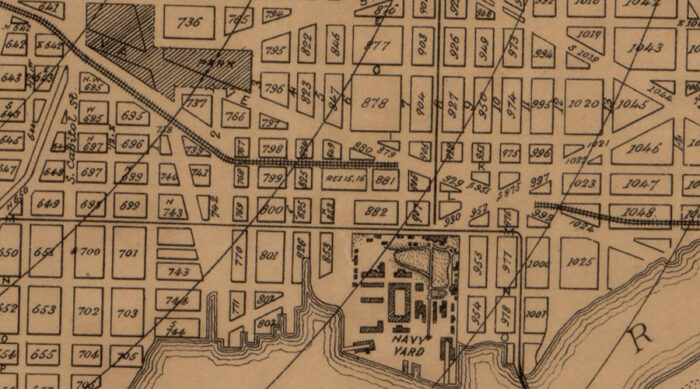
In looking over the history indigenous people on Capitol Hill, the lack of direct evidence is the most frustrating aspect. So, the finding of a major artifact from their time on the Hill should have really helped us expand our knowledge in this direction. Sadly, that was not to be, as we will see this week.
Ever since the Baltimore and Ohio railroad opened their connection to Washington in 1835, other railroads were interested in connecting the nation’s capital to their own networks. In 1853, the Baltimore and Potomac Railroad was chartered with the object of connecting Baltimore and DC. Work on tracks finally began in 1859, and was unsurprisingly slow through the Civil War. It was not until 1867, when the B&P was bought by the Pennsylvania Railroad, that work began in earnest.
The question was how to get the tracks through a city that had grown up dramatically since the B&O had build their tracks 30 years earlier. Since the B&O and Pennsylvania RR were competitors, there was no possibility of using the same tracks.
The final decision was to enter the city from the southeast, crossing the Anacostia upstream from the Navy Yard Bridge and then cutting through the city before slicing across the Mall near 6th Street NW and ending up in a newly built terminal in the heart of the city.
This meant that the tracks would have to cross 8th Street SE (also referred to as Garrison Street), the heart of Navy Yard Hill at the time. An at-grade crossing was out of the question, and building a bridge on flat land was not really an option at the time. The only possibility was therefore to build a tunnel, and work began in 1870, proceeding slowly due to the nature of the ground there, which required considerable lumber to hold back the gravel before proper masonry could be installed. The tunnel began just east of 11th Street, near the intersection with L Street, and exited at 7th and K Streets.

1884 map showing the B&P tunnel from the Anacostia River on the right to just south of the Capitol on the left. The dark line extending up 8th Street from the Navy Yard is the Washington & Georgetown Railroad (LOC)
The most exciting find along the way came in August of 1871. The Evening Star announced the discovery on August 15 of that year, under “Condensed Locals,” and squeezed in a paragraph about it between the news of a family vacation of Major Thomas H Bradley and the Witch of the Wake having won a boat race the previous day:
The workmen engaged in tunneling on the Baltimore and Potomac railroad near the navy yard, in this city, recently excavated an Indian canoe at the depth of about forty feet.
This news was picked up by the Alexandria Gazette and the Baltimore Sun, but that was it. There was no description of the vessel or how it might have been used. There also was no attempt to follow up on this remarkable find and what had happened to it, or any scientific examinations done on it.
The depth at which it was found was certainly intriguing. Most likely, the vessel had been abandoned in the upper reaches of the creek that ran north along what is today 8th Street SE, and had been buried when this land had been regraded to make way for that street. Any evidence for this would most likely have been destroyed during the tunneling operations 150 years ago, and would certainly not have survived the more recent rebuilding of that tunnel.
We are left, therefore, with an intriguing footnote to history, and one that it will impossible to elaborate on at this late date.
